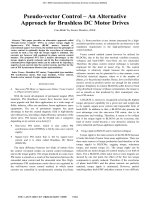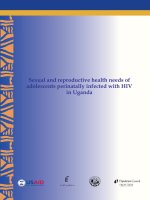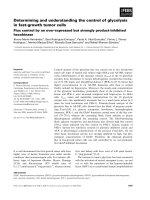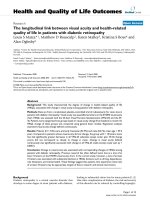Direct torque and indirect flux control of brushless DC motor with non sinusoidal back EMF without position sensor
Bạn đang xem bản rút gọn của tài liệu. Xem và tải ngay bản đầy đủ của tài liệu tại đây (1.25 MB, 5 trang )
Direct Torque and Indirect Flux Control of Brushless DC Motor with
Non-sinusoidal Back-EMF without position sensor
Abstract: In this paper, the position sensorless direct torque
and indirect flux control (DTIFC) of BLDC motor with
nonsinusoidal (non-ideal trapezoidal) Back-EMF has been
extensively investigated using three-phase conduction scheme
with six-switch inverter. In the literature, several methods have
been proposed to eliminate the low-frequency torque pulsations
for BLDC motor drives such as Fourier series analysis of
current waveforms and either iterative or least-mean-square
minimization techniques. Most methods do not consider the
stator flux linkage control, therefore possible high-speed
operations are not feasible. In this work,by using sliding mode
observer the mechanical rotor position is removed. The
proposed sensorless DTC method controls the torque directly
and stator flux amplitude indirectly using d–axis current. Since
stator flux is controllable, flux-weakening operation is possible.
Moreover, this method also permits to regulate the varying
signals. Simple voltage vector selection look-up table is
designed to obtain fast torque and flux control. Furthermore, to
eliminate the low-frequency torque oscillations, the new method
has been used to estimate the electromagnetic torque.
Simulation results confirm that the proposed three-phase
conduction DTC of BLDC motor drive with six-switch inverter
scheme.
Keywords: Brushless dc (BLDC) motor, sliding mode
observer, direct torque control (DTC), stator flux control,
fast torque response.
1. Introduction
Permanent magnet brushless machines are widely used
for servo drives, ship propulsion systems and traction
drives. Brushless AC (BLAC) drive back-EMF waveform
is sinusoidal and is supplied with SPWM voltage source
inverter, while the Brushless DC (BLDC) stator phase
currents are rectangular and its back-EMF is trapezoidal
due to concentrated windings. BLDC motor has better
efficiency, higher torque density, lower cost and simpler
structure, compared to BLAC motors. Further, BLAC
drive requires an accurate encoder sensor, while BLDC
drive needs to discrete position sensor such as Hall Effect
device.
Cost reduction of variable speed drives is growing
interest over these years. Elimination of the position
sensor are important subjects in low cost drives. Up to
now, many researches have been reported to control of
BLDC motor using six-switch three-phase inverter
(SSTPI).
Direct torque control (DTC) scheme was first
proposed by Takahashi [1] and Depenbrock [2] for
induction motor drives in the mid 1980s. More than a
decade later, in the late 1990s, DTC techniques for both
interior and surface-mounted synchronous motors
(PMSM) were analyzed [3]. More recently, application of
DTC scheme is extended to BLDC motor drives to
minimize the low-frequency torque ripples and torque
response time as compared to conventional PWM current
controlled BLDC motor drives [4], [5] and [6]. In [4], [5]
and [6], the voltage space vectors in a two-phase
conduction mode are defined and a stationary reference
frame electromagnetic torque equation is derived for
surface-mounted permanent magnet synchronous
machines with non-sinusoidal back-EMF (BLDC, and
etc.). It is shown in [5] that only electromagnetic torque
in the DTC of BLDC motor drive under two-phase
conduction mode can be controlled. Flux control is not
trivial due to the sharp changes whose amplitudes are
unpredictable depending on several factors such as load
torque, dc-link voltage, winding inductance, etc.
In this work, the torque control method with three-
phase conduction BLDC motor presented in [7] is used.
Also, unlike [7] to estimate the electromagnetic torque is
no need to use proposed
22 ×
matrix in [7], because the
new method has been used to estimate the
electromagnetic torque. As well as, in order to
elimination of mechanical position sensor a sliding mode
observer is used to estimate the rotor position.
As opposed to the prior two-phase conduction
methods, this DTC technique can control both torque and
stator flux of the BLDC motor simultaneously, therefore
field-weakening operation is possible. The proposed
sensorless DTC method controls the torque directly and
Reza Heidari*, GholamReza Arab Markadeh**, and Saeed Abazari***
*Department of Electrical Engineering, Shahrekord University, Shahrekord, Iran, E-mail:
**Department of Electrical Engineering, Shahrekord University, Shahrekord, Iran, E-mail: arab-
***Department of Electrical Engineering, Shahrekord University, Shahrekord, Iran, E-mail:
stator flux amplitude indirectly using d–axis current.
Unlike those for motor with sinusoidal back-EMFs,
optimal current references for a nonsinusoidal back-EMF
motor (BLDC) in the synchronous reference frame are
not constant, therefore current wave shapes require very
fast controllers in particular at high speed. Classical
bandwidth of the controller (such as proportional–
integral) does not allow tracking all of the reference
current harmonics [8]. Since the hysteresis controllers
used in the proposed DTC scheme are not fast controllers
like PI, they can easily regulate not only constant but also
the varying references (torque and flux). Simulation
results are presented to illustrate the validity and
effectiveness of the sensorless three-phase conduction
DTC of a BLDC motor drive with six-switch inverter.
2. The Proposed Sensorless DTC of Four-Switch
BLDC Motor Drive Using Three-Phase Conduction
2.1 Principles of the Proposed Method Title Block
Indirect torque control method of BLDC motor
explained in [9] was extended to a direct torque and
indirect flux control technique for six-switch inverter
BLDC motor in [7] which is suitable for field-weakening
operations. In this work, unlike [7] to estimate the
electromagnetic torque, fluxs and currents in dq reference
frame have been used.
The stator flux-linkage vector can be obtained from the
measured stator voltages
α
s
V
and
β
s
V
and currents
α
s
i
and
β
s
i
as
∫
∫
−=
−=
dtRiV
dtRiV
sss
sss
)(
)(
βββ
ααα
ψ
ψ
(1)
Where R is the stator winding resistance.
As was expressed earlier, in this paper, to estimate the
electromagnetic torque, fluxs and currents in dq reference
frame have been used. In order to establish this
transformation between any two frames of reference, let x
denote the reference frame to witch the variables are
being transformed, then
x
qdos
yx
y
qdos
fkf =
(2)
Where
f
is a variable such as, voltage or current and
so on.
−−
−−−
=
100
0)cos()sin(
0)sin()cos(
xyxy
xyxy
yx
k
θθθθ
θθθθ
(3)
Where
x
θ
and
y
θ
are electrical rotor position of first
and second reference farme, respectively. In order to
transformation between stationary reference frame and
rotor reference frame, relations will be as follows:
−
=
α
β
ψ
ψ
θθ
θθ
ψ
ψ
)sin()cos(
)cos()sin(
rr
rr
d
q
(4)
−
=
)sin()cos(
)cos()sin(
rr
rr
qd
k
θθ
θθ
βα
(5)
Where
r
θ
is the electrical rotor position.
2.2 Electromagnetic Torque Estimation in dq
Reference Frame
Because of the rotor position dependant terms in the
dq frame stator flux, conventional torque estimation in
stator reference frame used for DTC of sinusoidal ac
motors is no longer valid for BLDC motor, therefore a
new torque estimation algorithm is derived in dq frame
consisting of dq–axes fluxs and currents.
The torque estimation is the key factor in the proposed
DTC scheme that with the following relationship can be
obtained.
)(
4
3
dsqsqsdse
ii
P
T
ψψ
−=
(6)
Where P is the number of poles,
ds
ψ
,
qs
ψ
,
ds
i
and
qs
i
are the dq-axes fluxs and currents, respectively. As it
can be noticed that the equation (6) eliminates the speed
term in the denominator which causes problem at zero
and near zero speeds.
2.3 Control of Stator Flux Linkage Amplitude
Since BLDC motor does not have sinusoidal back-
EMF, the stator flux trajectory is not pure circle as in
PMSM. It is more like a decagon shape as shown in Fig.
1. Thus, direct stator flux amplitude control in a BLDC
motor is not trivial as in PMSM such that rotor position
varying flux command should be considered. However,
this is a complicated way to control the stator flux linkage
amplitude [5]. Therefore, in this work similar [7] instead
of
s
ϕ
itself its amplitude is indirectly controlled by d–
axis current. In [7] for six-switch BLDC motor drive, in
the constant torque region
*
r
ds
i
was controlled as zero
and in the flux-weakening region it was decreased for a
certain amount depending on the operational speed to
achieve maximum torque.The switching table for
controlling both the amplitude and rotating direction of
the stator flux linkage is given in Table I.
Fig. 1: Decagon trajectory of stator flux linkage in the stationary
αβ
–
plane.
TABLE 1. Switching Table For DTC of Four-Switch BLDC Motor
Using Three-Phase Conduction
Electrical rotor position
T
ϕ
6
θ
5
θ
4
θ
3
θ
2
θ
1
θ
1
v
6
v
5
v
4
v
3
v
2
v
1
1
5
v
4
v
3
v
2
v
1
v
6
v
-1
2
v
1
v
6
v
5
v
4
v
3
v
1
-1
4
v
3
v
2
v
1
v
6
v
5
v
-1
2.4 Sliding Mode Observer
Sliding mode observer can be used to estimate the
non-sinusoidal back-EMF values of BLDC motor. The
estimated stator currents and Back-EMF based on sliding
mode observer is obtained as:
=
=
++−
−
=
++−
−
=
)
~
(
ˆ
)
~
(
ˆ
)
~
(
ˆ
ˆˆ
)
~
(
ˆ
ˆˆ
2
2
1
1
ββ
αα
β
ββ
ββ
α
αα
αα
ss
ss
ss
ss
s
s
s
s
ss
ss
s
s
s
s
iSgnKe
iSgnKe
iSgnK
L
V
L
e
i
L
R
i
iSgnK
L
V
L
e
i
L
R
i
&
&
&
&
(7)
Where
βαβα
eeii
ss
ˆ
,
ˆ
,
ˆ
,
ˆ
are the estimation of
βα
−
axes stator currents and Back-EMFs respectively,
1s
K
and
2s
K
are constant coefficients, Sgn(.) is a sign
function and sliding surfaces are defined as:
−==
−==
ββββ
αααα
sss
sss
iiiS
iiiS
ˆ
~
ˆ
~
(8)
If sampling period is significantly less than electrical
and mechanical time constant then back-EMF value can
be assumed to remain constant. During each sampling
period and so:
0/,0/ == dtdedtde
βα
.
By subtracting (4) from (1), the estimation error of
stator currents and Back-EMF can be expressed as
−=
−=
−−
−
=
−−
−
=
)
~
(
~
)
~
(
~
)
~
(
~
~~
)
~
(
~
~~
2
2
1
1
ββ
αα
β
β
χβ
α
α
αα
ss
ss
ss
s
s
s
s
s
ss
s
s
s
s
s
iSgnKe
iSgnKe
iSgnK
L
e
i
L
R
i
iSgnK
L
e
i
L
R
i
&
&
&
&
(9)
Defining positive definite Lyapunov function V(x) as:
)
~~
(
2
1
22
βα
ss
iiV +=
(10)
Derivation of V(x) with respect to time concludes
0
~~
)
~
~
~
~
(
1
)
~~
(
2
1
2
1
22
<−−
+−+−=
βα
ββααβα
ssss
ss
s
ss
s
s
iKiK
ieie
L
ii
L
R
V
&
(11)
The lower bound of
1s
K
can be selected such that V
&
became negative definite and then the estimated stator
current components converge asymptotically to their
measured values.
2
1
~
~
~
~
~
1
s
ss
ss
s
s
i
ieie
LL
R
K
ββαα
+
−−>
(12)
It is sufficient that:
)
~~
(
1
1
βα
ee
L
K
s
s
+>
(13)
To decrease the chattering effects of large
discontinuous control law, near the sliding surfaces the
sgn(.) function is replaced with saturation function as:
−≤−
<
≥
=
qi
qii
qi
q
i
Sat
s
ss
s
s
~
1
~~
~
1
~
(14)
Where q is the sliding surfaces band.
In order to decrease the pure integrator influences in
Back-EMF estimation in (7), the integral operator is
replaced by a low pass filter.
Finally, the back-EMF sliding mode observer will
become:
)
~
(
~~
)
~
(
~~
2
2
βββ
ααα
sst
sst
iSgnKeKe
iSgnKeKe
+−=
+−=
&
&
(15)
Where
t
K is the higher cut-off frequency of low pass
filter.
3. Simulation Results
The drive system shown in Fig. 2 has been simulated
in order to demonstrate the validity of the proposed three-
phase conduction DTC of a six-switch BLDC motor drive
scheme with parameters has been shown in Table 2. The
controller sampling period is selected as 32 µs. The
magnitudes of the torque and flux hysteresis bands are
0.001N·m, and 0.001 Wb, respectively.
Implementations of torque, q– and d–axis rotor
reference frame stator currents and three-phase currents
and Back-EMFs responses of the proposed DTC of a
BLDC motor drive scheme are demonstrated in Fig. 3(a)
through (e), respectively under 0.5 N.m load torque
condition.
The torque reference is changed suddenly from 0.5
N·m to 0.25 N·m at 1 second. As seen in Fig. 3(a) that
fast torque response is obtained and the estimated torque
tracks the reference torque closely. The high frequency
ripples observed in the torque and current can be
minimized by properly selecting the dc-link voltage and
torque hysteresis band size.
Fig. 2: Block diagram of the direct torque and indirect flux control of four-switch BLDC motor drive using three-phase conduction mode without
position sensor.
(a)
(b)
(c)
(d)
(e)
(f)
(g)
(h)
(i)
(j)
Fig. 3. Simulation results of direct torque and indirect Flux Control
of Six-Switch Brushless DC Motor without position sensor when
refe
T
−
is changed from 0.5 N.m to 0.25 N.m at t=1 sec under
Ai
r
ds
0
*
=
, (a) generated torque, (b) q-axis stator current, (c) d-
axis stator current, (d) actual electrical rotor position, (e) estimated
electrical rotor position, (f) error of actual and estimated electrical
rotor position, (g) Three-phase currents, (h) Three-phase Back-
EMFs, (i) stator flux locus, (j) rotor flux locus.
βα
SS
VV ,
BLDC
*
em
T
*
r
ds
i
e
T
+
−
−
+
dq/
αβ
)(
4
3
r
dsq
r
qsde
ii
P
T
ϕϕ
−=
∫
∫
−=
−=
dtiRV
dtiRV
ssss
ssss
)(
)(
βββ
ααα
ϕ
ϕ
( )
3/2
baS
aS
iii
ii
+=
=
β
α
dq/
αβ
ObserverModeSliding
ee
qisatkeke
qisatkeke
bemf
SSt
SSt
)/(tan
)/(
)/(
1
2
2
∧∧
−
∧∧∧
∧∧∧
=
−−=
−−=
•
•
αβ
βββ
ααα
θ
0.9 0.92 0.94 0.96 0.98 1 1.02 1.04 1.06 1.08 1.1
0
0.1
0.2
0.3
0.4
0.5
0.6
0.7
Time ( sec )
Torque ( N.m )
0.9 0.92 0.94 0.96 0.98 1 1.02 1.04 1.06 1.08 1.1
-0.2
0
0.2
0.4
0.6
0.8
1
1.2
1.4
Time ( sec )
i
q
s
( In the rotor reference frame )
0.9 0.92 0.94 0.96 0.98 1 1.02 1.04 1.06 1.08 1.1
-0.8
-0.6
-0.4
-0.2
0
0.2
0.4
0.6
Time ( sec )
i
d
s
( In the rotor reference frame )
0.95 0.96 0.97 0.98 0.99 1 1.01 1.02 1.03 1.04 1.05
0
1
2
3
4
5
6
7
Time ( sec )
Actual electrical position
0.95 0.96 0.97 0.98 0.99 1 1.01 1.02 1.03 1.04 1.05
0
1
2
3
4
5
6
7
Time ( sec )
Estimated electrical position
1.018 1.019 1.02 1.021 1.022 1.023 1.024 1.025
-0.03
-0.02
-0.01
0
0.01
0.02
0.03
0.04
Time ( sec )
θ
actual
-
θ
estimated
1.44 1.45 1.46 1.47 1.48 1.49 1.5
-1.5
-1
-0.5
0
0.5
1
1.5
Time ( sec )
Three - phase currents ( A )
1.44 1.45 1.46 1.47 1.48 1.49 1.5
-80
-60
-40
-20
0
20
40
60
80
Time ( sec )
Three - phase Back - EMFs
-0.1 -0.05 0 0.05 0.1
-0.1
-0.05
0
0.05
0.1
Alfa - axis Stator Flux Linkage ( Wb )
Beta - axis Stator Flux Linkage ( Wb )
-0.1 -0.05 0 0.05 0.1
-0.1
-0.05
0
0.05
0.1
Alfa -axis Rotor Flux Linkage ( Wb )
Beta -axis Rotor Flux Linkage ( Wb )
In Fig. 4, the possibility of the flux-weakening region
operation is simulated when
*
r
ds
i
is changed from 0 A to
-1 A. As it can be seen in Fig. 4 that the shape of stator
flux linkage trajectory is kept same, however its
amplitude is smaller compared to the initial case which
means that the flux in the machine is weakened to obtain
maximum possible torque above the base speed. It is
concluded that in the proposed control scheme flux-
weakening operation is viable by properly selecting the
d–axis current reference as in PMSM drives. As a result,
there is no need to use position-varying stator flux
linkage amplitude
)(
res
θϕ
as a reference which is
complicated to obtain especially in the field-weakening
region.
(a)
(b)
Fig. 4. Simulated indirectly controlled flux linkage trajectory under the
sensorless three-phase conduction DTC of a BLDC motor drive when
*
r
ds
i
is changed from 0 A to -1 A under 0.5 N.m load torque, (a) d-axis
stator current, (b) stator flux locus.
Table 2. Parameters of BLDC motor
)(Ω
s
R
0.56
)(mHL
s
0.85
Flux induced by magnets (Wb) 0.07627
).(
2
mkgJ
0.0003617
) ( smNB
0.9444*e-4
Rotor pole numbers 16
DC link voltage (V) 36
Rated speed (rad/sec) 30
3. Conclusion
This study has successfully demonstrated application
of the proposed three-phase conduction direct torque
control (DTC) scheme for BLDC motor drives. It is
shown that the BLDC motor could also operate in the
field-weakening region by properly selecting the d–axis
current reference in the proposed DTC scheme. Also, a
Sliding mode observer is used to estimate the electrical
rotor position. Then, stator flux-linkage vector are
obtained from the measured stator voltages
α
s
V
and
β
s
V
and currents
α
s
i
and
β
s
i
, then by using (1) and (4) q-
and d-axis flux linkage are drived. Also, by usig (4) q-
and d-axis current are calculated. Finally, by using (6)
electromagnetic torque is estimated. A look-up table for
the three-phase voltage vector selection is designed
similar to a DTC of PMSM drive to provide fast torque
and flux control. The simulation results show the
effectiveness of the proposed method.
References
[1] I. Takahashi and T. Noguchi, “A new quick-response and high
efficiency control strategies of an induction motor,” IEEE Trans.
Ind. Appl., vol. 22, no. 5, pp. 820–827, Sep./Oct. 1986.
[2] M. Depenbrock, “Direct self-control of inverter-fed induction
machine,” IEEE Trans. Power Electron., vol. 3, no. 4, pp. 420–
429, Oct. 1988.
[3] L. Zhong, M. F. Rahman, W. Y. Hu, and K. W. Lim, “Analysis of
direct torque control in permanent magnet synchronous motor
drives,” IEEE Trans. Power Electron., vol. 12, no. 3, pp. 528 536,
May 1997.
[4] Y. Liu, Z. Q. Zhu, and D. Howe, “Direct torque control of
brushless dc drives with reduced torque ripple,” IEEE Trans. Ind.
Appl., vol. 41, no. 2, pp. 599–608, Mar./Apr. 2005.
[5] S. B. Ozturk and H. A. Toliyat, “Direct torque control of brushless
dc motor with non-sinusoidal back-EMF,” in Proc. IEEE-IEMDC
Biennial Meeting, Antalya, Turkey, May 3-5, 2007.
[6] G.R. Arab Markadeh and S.I. Mousavi, ‘Position sensorless direct
torque control of brushless DC motor based on back-EMF vector’ ,
ELECTROMOTION. pp. 128-138, 2009.
[7] S. B. Ozturk and H. A. Toliyat, “Sensorless Direct Torque and
Indirect Flux Control of Brushless DC Motor with Non-sinusoidal
Back-EMF,” IEEE, pp. 1373-1378, 2008.
[8] F. Bodin, S. Siala, “New reference frame for brushless dc motor
drive,” in Proc. IEE-PEVD Annu. Meeting, London, UK, Sep. 21-
23, 1998, pp. 554-559.
[9] P. J. Sung,W. P. Han, L. H. Man, and F. Harashima, “A new
approach for minimum-torque-ripple maximum-efficiency control
of BLDC motor,” IEEE Trans. Ind. Electron., vol. 47, no. 1, pp.
109–114, Feb. 2000.
[10] J. Hu, B. Wu, “New integration algorithms for estimating motor
flux over a wide speed range,” IEEE Trans. Power Electrons., vol.
13, pp. 969–977, Sep. 1998.
0.9 0.92 0.94 0.96 0.9 8 1 1.02 1.04 1.06 1.08 1.1
-2
-1.5
-1
-0.5
0
0.5
Time ( sec )
i
d
s
( In the rotor reference frame )
-0.1 -0.05 0 0.05 0.1
-0.1
-0.05
0
0.05
0.1
Alfa - axis stator flux linkage ( Wb )
Beta - axis stator flux linkage ( Wb )









